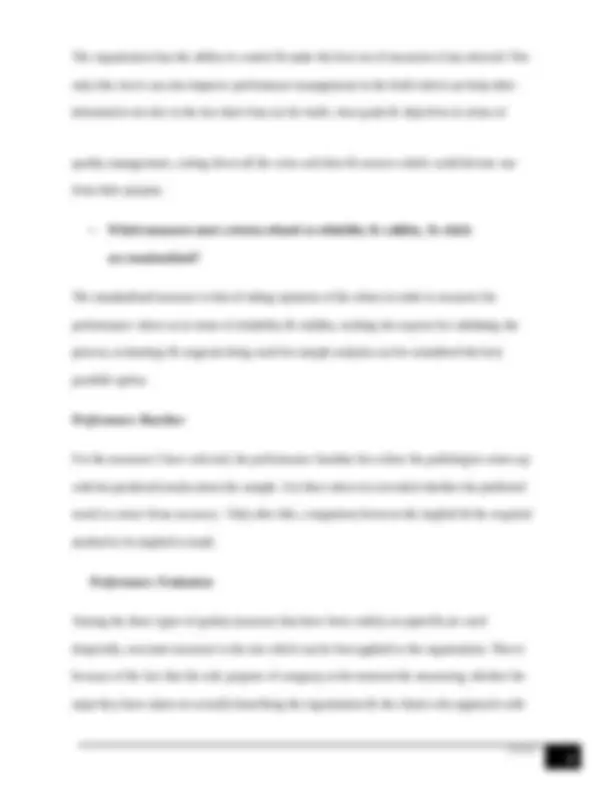





Study with the several resources on Docsity

Earn points by helping other students or get them with a premium plan


Prepare for your exams
Study with the several resources on Docsity

Earn points to download
Earn points by helping other students or get them with a premium plan
Community
Ask the community for help and clear up your study doubts
Discover the best universities in your country according to Docsity users
Free resources
Download our free guides on studying techniques, anxiety management strategies, and thesis advice from Docsity tutors
Performance Management Plan Proposal HLT 313V latest update 2023
Typology: Exams
1 / 7

This page cannot be seen from the preview
Don't miss anything!




[Date]
Grand Canyon University Forensic Toxicological Laboratory Organizational Goals: For forensic toxicological lab, following should be the organizational goals with respect to quality management:
[Date] its technology & bring more technological advancements to the laboratory. The organization also intends to introduce training session in upcoming days, inviting some of the renowned professionals of this field to train the pathologists. Training of the pathologists would help ensure that the chances of error have been minimized & that the result can be brought way closer to accuracy. This training would also help eliminating the chances of sample contamination, which is one of the basic reasons as to why the predicted result at times is far from accuracy. Summary of Relevant Performance Measure: Only making a list of goals & objectives will not work out for the organization. The organization will have to ensure that whether the things are working out for them or not. Hence for this, the idea of performance measurement needs to be implemented. Performance measurement can be done in a number of ways. However, for the forensic toxicological lab, the best way to measure performance is through the opinion of clients. If the clients are satisfied with the results, the meeting of deadlines then it can be said that performance is up to the mark. Also performance can also be measured here by means of taking help from the experts. Once the pathologists are done with their tasks, they will have to present their work in front of the experts & explain what made them reach to this conclusion, which technology they preferred & why, what did they treat the sample with & other related questions. It is then that the expert will decide whether the pathologist has learned to avoid sample contamination, correct identification of the required method of analysis or that they need more to be trained to achieve excellence in maintaining the quality of the services being provided at the laboratory.
- How well measures will align with your stated goals? These measures align very well with the stated goals since they intend to improve the quality. In
[Date] The organization has the ability to control & make the best out of measures it has selected. Not only this, but it can also improve performance management in the field which can help other laboratories too due to the fact that it has set for itself, clear goals & objectives in terms of quality management, cutting down all the extra activities & sources which could deviate one from their purpose.
- Which measures meet criteria related to reliability & validity, & which are standardized? The standardized measure is that of taking opinions of the others in order to measure the performance where as in terms of reliability & validity, seeking the experts for validating the process, technology & reagents being used for sample analysis can be considered the best possible option. Performance Baseline: For the measures I have selected, the performance baseline lies where the pathologist comes up with his predicted results about the sample. It is then when it is revealed whether the predicted result is correct from accuracy. Only after this, comparison between the implied & the required method to be implied is made. Performance Evaluation Among the three types of quality measures that have been widely accepted & are used frequently, outcomes measure is the one which can be best applied to the organization. This is because of the fact that the sole purpose of company at the moment the measuring whether the steps they have taken are actually benefiting the organization & the clients who approach with
[Date] their cases to the organization or not. Outcome measure can be considered best when it comes to measure the outcome of health care provider service on individuals who avail the service (Frieden, 2014). By utilizing it, one can easily assure if the laboratory is actually fulfilling the quality standards & needs of individuals or that all its hard work is going into vain. Definition of Success: For organization, the meaning of success is to make fair & accurate dealings with the clients & that to ensure that all that is being predicted does not harms anyone in any aspect. The organization believes their success is when the technologies they have installed, the pathologists they have trained & the experts they have hired all in combination serve the humanity in positive way rather than causing distress to it. It also intends & regards it a success if they are able to assist the law enforcement agencies in terms of eliminating the evil from society. References: Council of Medical Specialty Societies (CPSS) 2014. The Measurement of Health Care Performance: A Primer From the Council of Medical Specialty Societies. Retrieved from: http://www.cmss.org/uploadedFiles/CMSS_Quality_Primer.pdf Frieden, 2014. Six Components Necessary for Effective Public Health Program Implementation, American Journal of Public Health pg 24(2). Snifer, 2010. Process Action Team in Health Care. Performance Improvement. Retrieved from
[Date] measuring earnings by quantity of production such as a piece goods arrangement, or any factor other than sex- for example, salary differentials that stem from unequal starting salaries based on differences in experience levels” (Repa, 2017). Reference Repa, B.K. (2017). Your Rights Under the Fair Labor Standards Act. Retrieved from http://www.nolo.com/legal-encyclopedia/free- books/employee-rights-book/chapter 2 - 3 .html